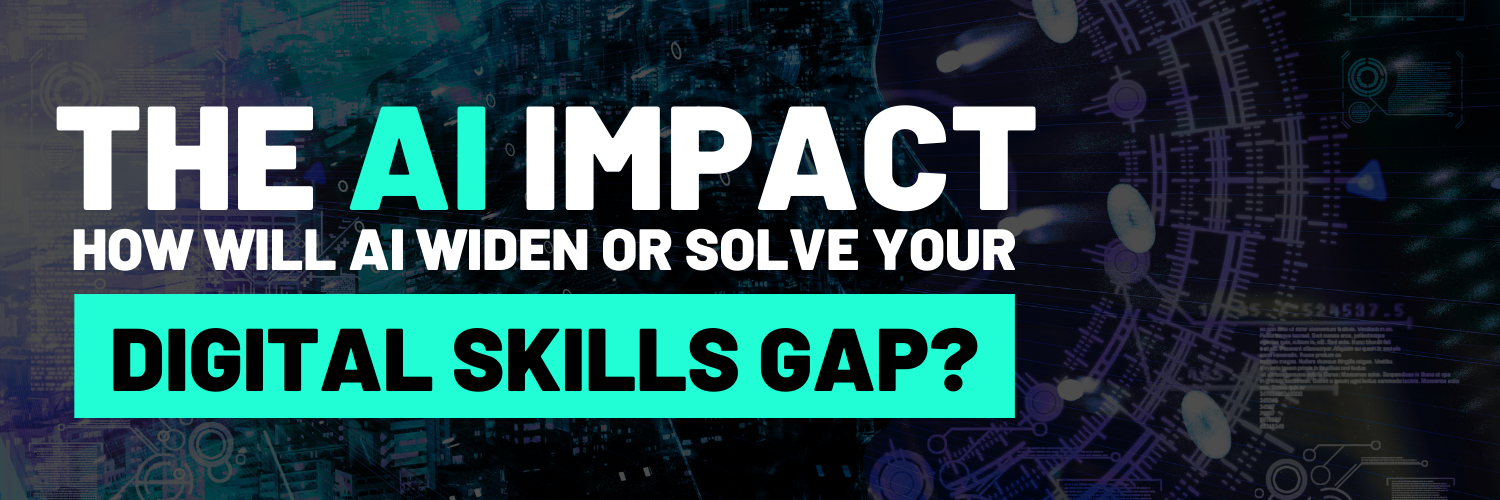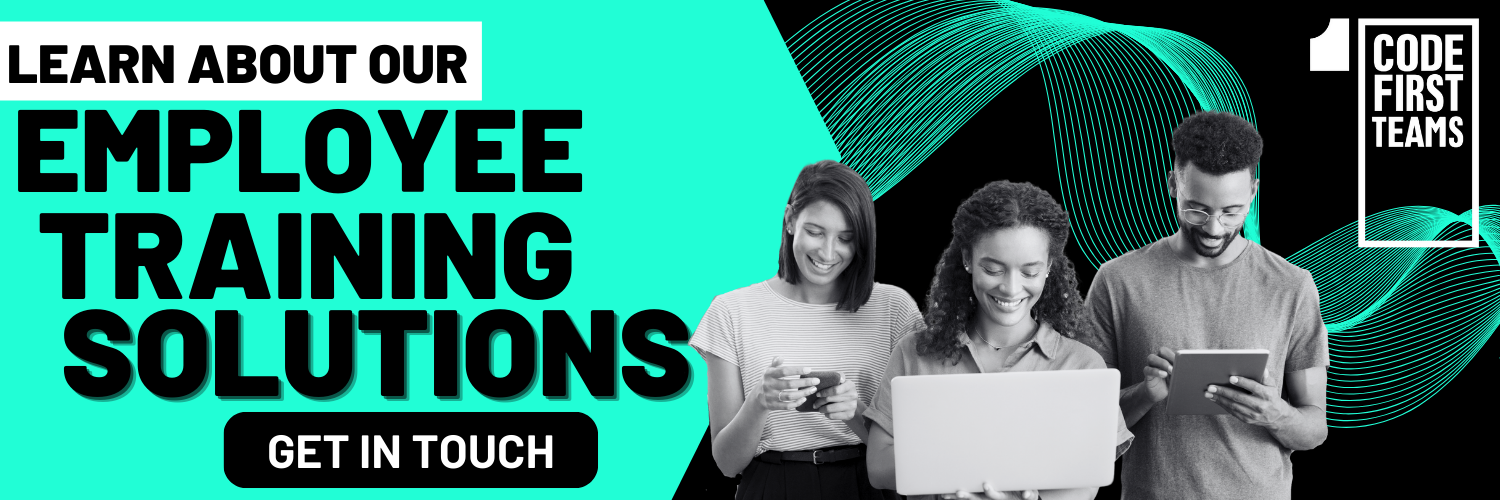
Content Menu
How Will AI Widen or Solve Your Digital Skills Gap?
The rapid advancement of AI is reshaping industries, creating new opportunities, and introducing new challenges. For businesses already struggling with a digital skills gap, the rise of AI presents a critical question: Will artificial intelligence deepen the divide or help to bridge it?
With talent shortages on the rise and 86% of business leaders expecting AI to transform their industries by 2030, identifying and bridging your AI skills gap has never been more crucial.
Understanding the digital skills gap
The digital skills gap is widening as technological advancements outpace traditional workforce training. PwC’s 2024 Global CEO Survey highlights that 69% of Global CEOs anticipate that AI will require most of their workforce to develop new skills.
All of this unfolds against the backdrop of an unfinished skills revolution—the rise of electronics, computers, and the internet. While these technologies may feel ubiquitous, it’s only in the past 30 years that they’ve become essential to everyday life. This has driven the need for expertise in software, data, and computing. Now, organisations face a dual challenge: navigating the ongoing demands of the digital era while preparing for the rapid advancements of the AI age.
With the advancements in AI heavily impacting digital skills, this two-fold skills gap presents a major risk for businesses. It can lead to lower productivity, inefficiencies, and a lack of innovation. Without a proactive approach to addressing both challenges, companies will fall behind. Many are already finding it increasingly difficult to keep up, let alone excel, in the ever-changing environment of AI-driven workplaces.
How AI can be a strong catalyst for growth
AI can serve as a powerful tool to bridge the digital skills gap, benefiting individual employees as well as wider business functions. Here’s how:
- AI-powered learning platforms: Adaptive learning technologies can personalise training for employees, ensuring they gain the skills they need at their own pace. By tailoring learning, employees are more likely to engage with and see the value of training programmes, increasing their success.
- Automation as an enabler: AI can take over repetitive tasks, allowing employees to focus on strategic and creative problem-solving, rather than being replaced entirely. AI can also provide real-time insights, coaching, and support, making digital skills more accessible to a wider workforce.
- Democratising access to knowledge: In the past, we have seen certain skills requiring lengthy time commitments and expensive education. AI is able to lower barriers to entry across a range of skills, such as website design and complex data analysis. By simplifying complex processes, AI is enabling people from diverse backgrounds access to the skills and insights they need to succeed.
- Workforce & strategic planning: Because of its ability to manage large quantities of data, AI is able to reveal patterns across multiple business functions. This insight can help HR professionals make informed decisions about strategic workforce planning, from hiring new talent to upskilling existing employees in required skills.
By personalising learning, automating repetitive tasks, and making knowledge more accessible, AI can help employees build critical skills faster and more effectively. All of this demonstrates the opportunity AI provides to not just close the digital skills gap, but to empower individuals and businesses to make smarter, more data-driven decisions.
Keep pace or risk falling behind
While AI has huge potential to bridge the digital skills gap, we can’t ignore the risks. There are some challenges that could unintentionally lead to wider gaps if not addressed properly:
- Unequal access to AI tools and training – AI training shouldn’t be limited to tech employees. Non-tech and tech-adjacent teams also need to learn how to use it effectively while ensuring compliance with GDPR and protecting sensitive company data. Misuse can lead to serious breaches, particularly in high-risk industries like finance and defence.
- Automation without reskilling – As AI takes over routine tasks, employees without the necessary digital skills may struggle to transition into more strategic roles, leaving a growing segment of the workforce at risk of redundancy. Often, women are more affected by restructures than men, which could lead to a widening of the gender gap in tech.
- Bias in AI-driven hiring and training – There are key diversity issues we must address in the rollout of AI; if models are trained on biased data, they may reinforce existing inequalities. This has the potential to limit opportunities for underrepresented groups and make it harder to create a truly diverse and inclusive workforce.
- The pace of AI evolution – As AI continues to advance rapidly, businesses that fail to keep up with continuous learning and development will find their employees’ skills becoming obsolete faster than ever, exacerbating the digital skills gap instead of closing it. The current half life for skills is just five years, and this is sure to drop as technology advances, underscoring the risk businesses face if they don’t keep up.
Without the right strategies in place, AI could accelerate job displacement, deepen inequality, and make it harder for businesses to keep pace with rapid technological change. Understanding its impact on the individual roles as well as the entire workforce is vital to ensuring it works for you, not against.
Actionable steps for employers
AI is not just another technological trend; it’s a fundamental shift in how work is done. Whether it will deepen the digital skills gap or bridge it depends on how organisations respond, and how quickly.
To benefit, there are several actions organisations need to take:
- Prioritise AI literacy: Instead of limiting AI learning to tech teams, offer accessible courses for all employees, helping them to use AI effectively without risking data security. Courses like our AI Essentials programme can support this training.
- Use AI-driven learning platforms: AI-powered training platforms can adapt to individual learning styles, keeping employees engaged and ensuring they develop skills relevant to their roles.
- Upskill from within: Rather than relying on external hiring, invest in your existing employees. Code First Teams can help to retrain your workforce, ensuring no one gets left behind in the age of AI.
- Foster a culture of continuous learning: Encourage employees to stay ahead of AI trends by offering regular workshops, hands-on projects, and mentorship programmes.
The digital skills gap is a challenge that businesses can’t afford to ignore, and the time to act is now. AI upskilling is not just about keeping up; it’s about staying ahead.
GET IN TOUCH WITH CODE FIRST TEAMS
Companies around the world trust Code First Teams to:
- Upskill all employees with essential low code/no code skills for non-technical or tech-adjacent roles
- Provide skills to accelerate tech career development and progression
- Close the internal digital skills gaps through reskilling and upskilling programmes with in-demand tech skills
Why not find out for yourself? Speak to our experts here. 👇



















